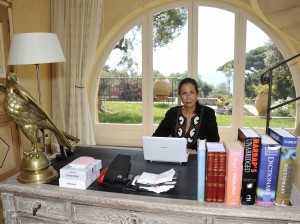Writers’ rooms
Writers’ rooms
Writers’ rooms
-
Hannah
-
Hannah
Regular readers of my blog will know that settings are a big inspiration for me in my writing. I love to write outdoors, amid the lush, vivid colours of gardens, the hum of crickets and the melodies of the birds; but of course sometimes the south of France is too hot, and Kent is too chilly or damp, so then I retreat to my writing room.
For me, the essentials in a writing room are a comfortable chair, a large desk, a lamp, a pile of English reference books and – of course – a window with an inspiring view. Here’s a picture of me in my writing room in my French home. I usually sit at the other side of the desk, looking out onto the garden and the blue Mediterranean beyond.
My writing room is my haven – a place where I’m cosy and creative, and where the muse visits me.
Because settings are so important to me, I’ve long been fascinated by other writers’ room as well. The Guardian ran a wonderful series on writers’ rooms – 116 are featured at http://www.guardian.co.uk/books/series/writersrooms. The articles are just fascinating:
• Simon Callow writes in theatre dressing rooms.
• Justin Cartwright has a kitchenette in his writing room, so he can hole up and write all day.
• Miranda Seymour writes in her bedroom at a cluttered old desk.
• Louis de Bernières writes in a summer house at the end of the garden.
• Sebastian Faulks writes in a small flat in Holland Park, separate to his home.
• Jane Austen wrote upstairs in her father’s rectory on a tiny, 12-sided table.
• The Brontë sisters worked in the parlour together, chatting about their writing.
• Roald Dahl wrote in a garden shed, with his feet in a sleeping bag to ward off the chill.
It’s such a shame that the Guardian seems to have terminated this series (the last article was in 2009), because there are so many more authors whose writing spaces and habits I’d love to see. It would make a wonderful book, don’t you think: the writing spaces of authors?
